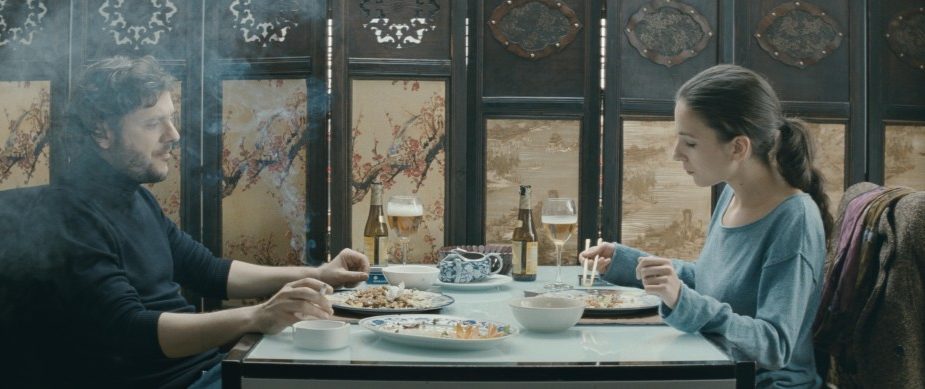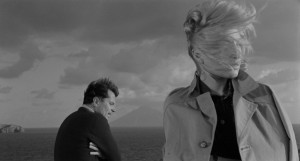Romanian auteur Corneliu Porumboiu’s brilliant When Evening Falls on Bucharest or Metabolism (2013; screening Friday, March 20 at 9:00 p.m. and Saturday, March 21 at 5:30 p.m.) opens with an extended nocturnal dialogue, filmed inside an automobile, with the camera statically shooting the conversing couple. The driver, a film director named Paul (Bogdan Dumitrache), informs his actress passenger Alina (Diana Avramut) that the two of them will be shooting a nude scene the next day. Paul’s disclosure inaugurates a conversation about both whether screen nudity needs to be narratively justified, and also the nature of the director’s motivation for including the scene. In thus beginning his film, Porumboiu establishes a narrative expectation (in this instance, of seeing his actress nude – a European art-house trope if ever there was one) that the film proceeds to thwart for a good portion of its eighty-nine minute duration; when Porumboiu finally delivers on the promise, the terms of the first-scene discussion will indeed prove relevant. When Evening Falls on Bucharest or Metabolism, in other words, knows what you want – and will take pleasure in frustrating, and making you think about, that desire.
The opening set-piece also establishes a self-awareness of those stylistic choices adopted not only in this latest signature achievement of the New Romanian cinema, but across the broader, early twenty-first century Eastern European movement, from Cristi Puiu’s The Death of Mr. Lazarescu (2006) to Cristian Mungiu’s Beyond the Hills (2012) to Porumboiu’s own masterful Police, Adjective (2009). In particular, Porumboiu seems set on calling attention to his and his countrymen’s use of the long-take within the shifting contexts of celluloid and digital cinema. During this same opening set-piece, filmed in a single shot, Paul observes that film does not allow the director to shoot for longer than eleven minutes at a time – a duration that When Evening Falls on Bucharest would appear to be testing in this opening scene, at least at first – while digital has no such limitation. Paul, in a confession that seems appropriate for the long-take dependent movement as a whole, insists that he was taught to think of the world in these eleven minute intervals (rather than, not only, digital cinema’s infinity, but also the more rapid analytic editing strategies of both commercial and more conventional art cinema).
When Evening Falls on Bucharest or Metabolism is, in this sense, self-conscious of the storytelling strategies that the film shares with many of the more prominent examples of the New Romanian cinema. It is also overtly self-aware of the codes of realism that obtain through the same artistic choices, namely by refusing to manipulate the space and time of the observed world through editing. However, as a work about process, about making a nude scene, and indeed about showing life in all its banality – Paul insists that his actress dry her hair for ten minutes – Porumboiu reveals the artifice of the conventionally real; we see in this work that the quotidian, everyday subjects of both this film (the numerous conversations, meals, and conversations about meals) and the film-within-the-film, are indeed staged for the camera, with considerable deliberation. Rather than swallowing the viewer up in its story, When Evening Falls on Bucharest or Metabolism encourages the spectator to take a step back and think about the codes and conventions with which this work is playing, and in many instances challenging its audience.
None of this makes Porumboiu’s film original exactly, though it is perhaps more direct in addressing the nature and assumptions of the New Romanian cinema than any of the many substantial examples that have come before it – and with a good deal more humor and wry observational detail too. In fact, in its systematic battle with narrative expectations, When Evening Falls on Bucharest or Metabolism finds itself to be an heir to the tradition of Michelangelo Antonioni’s supreme masterpiece of elegantly choreographed ennui, L’Avventura (1960; screening one night only, this Friday, March 20 at 6:00 p.m.), which Porumboiu references in the question included in this piece’s title, as well as in Alina’s commented upon resemblance to that film’s striking heroine, Monica Vitti. In thus crystallizing the connection between When Evening Falls on Bucharest or Metabolism and L’Avventura, Porumboiu’s feature not only confirms the theoretical parameters of the New Romanian cinema; he also places it in much longer, and very rich modernist European art-house tradition for which the national movement may just be the most conspicuous (though by no means only) current manifestation.
One last word, about that title: as awkward and unruly as it may seem to be, When Evening Falls on Bucharest or Metabolism reinforces the dual preoccupations of the New Romanian cinema, once again of time and realism. The former (“When Evening Falls on Bucharest”) provides the time of the day in which Porumboiu’s female lead will leave (and presumably her affair with the director will end), while the even more mysterious “Metabolism” tells of something that a more conventional cinema would rarely show, and for good reason: an on-screen endoscopy, which the Romanian director includes to comic effect, in keeping with the finely honed sense of humor he first demonstrated in 2006’s 12:08 East of Bucharest. An intentionally frustrating modernist art cinema? Yes. A pleasure-less experience? Most certainly not.
***
As is indicated above, L’Avventura will be screening along with, and indeed in preparation for When Evening Falls on Bucharest or Metabolism, later this week. However, L’Avventura’s importance to Museum Film’s March program is by no means limited to this connection. To begin with, L’Avventura premiered, alongside Federico Fellini’s equally scandalous, though less influential La Dolce Vita (1960) – last week’s repertory title at the Museum – at the 1960 Cannes Film Festival. Both films generated widespread controversy, before becoming major box office hits both at home (in Italy) and abroad. Likewise, an astonishingly short two years after its release, L’Avventura was voted the second best film of all-time in the definitive Sight & Sound critics’ poll, finishing behind only Orson Welles’s Citizen Kane (1941). Welles’s classic, as it happens, will introduce “Orson Welles & Identity: Celebrating the Director at 100,” a week from Thursday (March 26, at 7:30 p.m.) at OKCMOA. This March at the Museum, it all returns to L’Avventura – as has been true of the many films and movements made in Antonioni’s magisterial, five-and-a-half decade wake.











